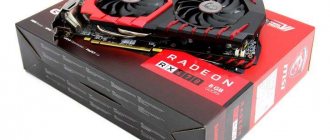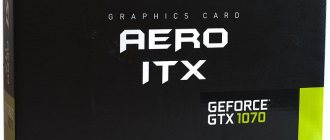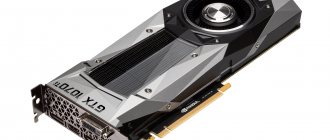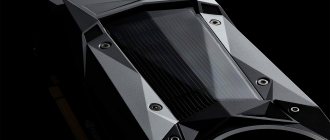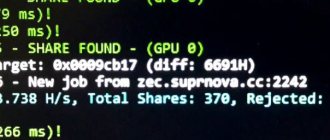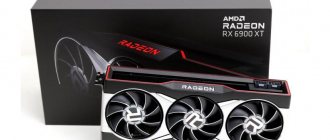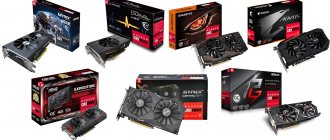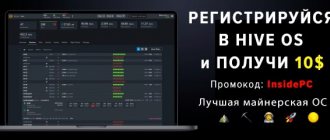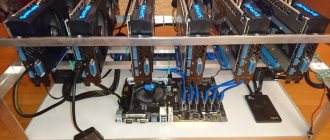A few years ago, video cards from Nvidia could easily be called ineffective in terms of mining cryptocurrencies. Users noticed that even the strongest GPU at that time was inferior in mining to almost any Radeon device.
But the popularity of virtual currency led to the fact that competitors began to release more and more powerful video cards optimized specifically for mining.
Now Nvidia can boast of a product that is currently considered one of the best in terms of performance. This is a Geforce GTX 1070 .
The video card is an improved version of the GTX 980 Ti, which was also once in the top of the best. But the new series has become a real breakthrough, as some of its aspects are 3 times superior to its predecessor. It is logical that in version 1070 mining becomes more productive.
This was achieved through the use of Pascal . Chips running on previous generation configurations are not capable of producing such results. Low energy consumption also played a decisive role in efficiency. Now the farm will not require such large expenses as before.
But there is also a drawback. Manufacturers produce this series of GPUs with Micron memory. This is not the best option, as it is inferior in overclocking capabilities to other chips. For example, Samsung manages to optimize for currency mining much more effectively.
Mining Ethereum
Let's see what kind of mining performance the GTX 1070 will bring to Ether mining.
We get these results with standard video card settings. The hashrate is almost 26 mh/s. This is a good indicator, considering that the overclocking process has not yet been carried out. But this is what we get after it.
Computing power rises to 30 mh/s, which can be increased to 30.5 if the memory frequency is slightly increased (to 650) and the core MHz is lowered to 100.
The older RX series (470, 570) from Radeon produced the same performance results. But there the profit was covered by the costs of electricity. In our case, power consumption reaches only 120 watts, which is quite a bit for such power.
Now let's see what power the NiceHash calculator will show us.
Here you can see even more – as much as 32.86 mh/s hashrate.
The result varies depending on the video card model used. In Ethereum mining, the changes are insignificant (1-2 mh/s). But power consumption and temperature can vary greatly for each model.
| Video card | ETH hashrate | Temperature |
| EVGA GTX 1070 SC 8GB | 30-31 mh/s | 59-64° |
| ASUS STRIX GTX 1070 | 31.5 mh/s | 63° |
| Gigabyte Founders Edition GTX 1070 | 31.7 mh/s | 69° |
| EVGA Founders Edition GTX 1070 | 31.2 mh/s | 66° |
The temperature is reduced using cooler settings. In all video cards, the cooler did not work at full capacity (in the first case, only 31%).
There are 2 miners involved in testing: Claymore Ethereum miner and Nvidia Optimized Miner. The first one showed a hashrate of 32 mh/s. The second one turned out to be the winner and produced 32.3 speeds. Both programs operated at the same frequencies and consumed the same amount of energy.
Many people think that Nvidia is a bad choice for Ether mining. But this GPU showed good results. This is especially noticeable if you compare the performance of the video card with its predecessor - the GTX 1060 (6gb).
The GTX 1070 is almost 8 mh/s ahead.
Our editors do not recommend using GTX 1070 video cards for Ethereum mining. The 1070 video card shows the best results in mining using the Equihash algorithm.
Mining Zcash
GTX video cards are also known among miners for being profitable for mining Zcash (Radeon is not so good at this). Let's see if our version - 1070 - will retain this title. And this is the result obtained - 434 Sol/s .
Now let’s compare how much overclocking the 1070 series will bring to mining.
Just a little power is missing to reach 500 Sol/s . But what we have is quite enough to give a positive assessment. With this performance, 130 watts of energy are consumed. The Power Limit should be reduced to 90.
Now let's check what result we get with other settings.
| Currency | Hashrate | Frequency | PowerLimit |
| Zcash (no overclocking) | 445 Sol/sec | +0/+0 | 100% |
| Zcash (overclocked) | 475 Sol/sec | +100/+720 | 80% |
The video card used was a Gigabyte Geforce GTX 1070 8GB. In this case, the calculation speed was lower. But with the help of overclocking, it was possible to reduce energy consumption from 180 Watts to 140. In both cases, EWBF's CUDA Zcash Miner .
Let's see what the Nicehash calculator tells us:
Here the results are much better. Although the video card will need 181 watts for such power. Assembling a mining rig for 1070 with such a consumption rate will be problematic.
Solving low hashrate problems
Some miners building farms on the GTX 1070 complain that the hashrate is too low, not exceeding 2.5 megahashes per second. Updating drivers and the mining application does not help the situation. The problem appears when using Windows 10. There are two ways to solve it:
- switch to Ubuntu;
- update Windows to version 1703 or higher.
The second method is simpler and faster, but the first allows you to once and for all get rid of regular problems that arise when working on a Microsoft OS.
Dual Mining
First, let's try the ETH + DCR combination without overclocking settings.
The result cannot be called successful. Decred produces very little power. Compared to the Radeon, the RX 400 series delivered 3 times the speed.
Now let's try the ETH + Sia combination.
The result got better. Let's check what results we get with overclocking. The frequency will be set to +105 for the core, and +600 for the memory. Power Limit is set at 90.
Derced's production did not increase even in this case. Although an increase in the speed of ether was obtained, this is not enough to call such a process profitable. But the second combination was able to please us.
The speed of both currencies has been increased. This means that such dual mining can be called profitable.
Our editors also do not recommend using Dual mining on GTX 1070 video cards. The Equihash algorithm shows much better results when mining the same Zcash.
Conclusion, relevance of investment.
Based on the current mining profitability on the Nvidia GTX 1070 , which is up to three dollars per day, the cheapest 1070 video card costing about $350 will pay for itself in 4 months, but finding these cards, especially for that price, is almost impossible.
In Ukraine, the GTX 1070 sells for $500 and above. With the current income of 1070, you can buy at this price, but who knows how much time will be left before the next correction, and maybe even before a new dump. Of course, after the recession there will be a new rise, but saving cryptocurrency until then is only possible if you invest free funds and do not go into debt, hoping for an instant return. Mining is always a long-term investment with a high degree of risk. But the income in this business can be an order of magnitude higher than in any other legal business.
To work for the future, you need to purchase new models, and the 1070 has not been one for a long time. Such cards can only be purchased at a very low price, but it is better to overpay and get the RTX 3060 Ti. However, let everyone decide for themselves. Happy mining!
Mining on other algorithms
Other algorithms are used less frequently, but can still be quite profitable.
| Algorithm | Speed | Energy consumption |
| Ethash | 30.0 Mh/s | 120.0 |
| Groestl | 33.5 Mh/s | 130.0 |
| X11Gost | 11.5 Mh/s | 120.0 |
| Cryptonight | 630.0 H/s | 100.0 |
| Equihash | 430.0 H/s | 120.0 |
| Lyra2REv2 | 35500.0 kh/s | 130.0 |
| NeoScrypt | 1000.0 kh/s | 130.0 |
| TimeTravel10 | 18.5 Mh/s | 120.0 |
| X16R | 8.0 Mh/s | 130.0 |
| SkunkHash | 27.5 Mh/s | 120.0 |
| Nist5 | 44.0 Mh/s | 130.0 |
| Xevan | 3.0 Mh/s | 120.0 |
Mining Monero (Cryptonigt) turned out to be unprofitable on this GTX1070. The speed reaches only 630 kh/s, and consumes 100 watts of electricity. The NiceHash calculator shows a little more hashrate, but this is still not enough.
With the current Bitcoin rate, there will be no point in mining the currency even with overclocking. Below is a table with similar algorithms - the mining of which will not bring good profits.
| Algorithm | |
| NeoScrypt (Experemental) | |
| Lyra2Rev2 (ccminer) | |
| Pascal (excavator) | |
| X11Ghost (ccminer) | |
| X11Ghost (ccminer_alexis) | |
| Blake2s (excavator_server) |
Using the WhatToMine calculator you can find out how much profit each algorithm will bring per day on a specific service. In a special column opposite each algorithm you can see the daily income taking into account electricity costs.
Performance of all GTX 1070 models
To correctly predict the profitability of a GPU farm, it is important to consider what parameters a particular model produces. The following video cards turned out to be the most productive:
| Model | Core | Memory | Ether mining | Zcash mining | Temperature | Watt |
| GTX 1070 Gigabyte G1 | 80 | 900 | 33,3 | 500 | 59 | 260 |
| GTX 1070 Palit GameRock | 150 | 800 | 32,5 | 520 | 52 | 260 |
| GTX 1070 Gigabyte mini | 170 | 750 | 32,5 | 500 | 57 | 230 |
| GTX 1070 Inno3D twin x2 | 200 | 700 | 32,5 | 500 | 58 | 230 |
| GTX 1070 Asus turbo | 160 | 750 | 32 | 490 | 65 | 230 |
| GTX 1070 Aorus | 90 | 700 | 32 | 500 | 61 | 260 |
| GTX 1070 Palit dual | 150 | 700 | 32 | 485 | 68 | 230 |
| GTX 1070 Palit Super JetStream | 100 | 850 | 31,5 | 510 | 54 | 250 |
| GTX 1070 Gigabyte WindForce | 150 | 600 | 31,5 | 500 | 62 | 260 |
| GTX 1070 Asus Strix | 50 | 550 | 31 | 500 | 52 | 260 |
| GTX 1070 MSI Gaming X | 100 | 600 | 31 | 500 | 57 | 260 |
| GTX 1070 Asus Dual | 100 | 600 | 31 | 475 | 58 | 225 |
| GTX 1070 MSI Aero | 150 | 550 | 30,7 | 480 | 62 | 230 |
| GTX 1070 MSI Aero REF | 150 | 550 | 30,7 | 480 | 72 | 230 |
| GTX 1070 MSI Armor | 150 | 550 | 30,6 | 490 | 59 | 240 |
| GTX 1070 Asus Expedition | 100 | 550 | 30,2 | 460 | 58 | 210 |
Using this table, you can determine the best video card based on the “Performance - Power Consumption” ratio. The cooler worked at maximum power everywhere. Each model uses the same memory system - Micron . The other models are only a couple of units of hashrate over the air. Although Zcash continues to show the same result.
Drivers have been updated. Also overclocked for Zcash currency. But this did not help in all cases.
The worst result was shown by the Asus Expedition model, which loses in almost all respects. It has low consumption, but it still won't cover that much processing power.
Which GTX 1070 is the best for mining?
Using the table above, it is easy to compile the top productive GTX 1070 for mining. But let’s give other parameters by which it is better to select models. For example, reference models overclock well. But at the same time they get very hot. Overclocking the GPU, the average temperature will be 72 degrees. We take into account that the room temperature is 25–27 degrees. It immediately becomes clear that making a farm from such devices is unsafe in the long term.
The optimal cooling system is when the power circuits are blown along with the chip. Unfortunately, such video cards will cost more. This means that not only the service life will increase, but also the payback time.
The Gigabyte model is often chosen by miners thanks to the successful G1 and WindForce series. But users also noticed that compared to other GPUs, weak coolers are installed here. The G1 series has 3 installed, which will provide good cooling even if the fans are not running at full power.
NVIDIA Founders Edition shows both good performance and optimal temperatures. But you have to pay for this with a high noise level at maximum load.
ASUS Strix also shows good computing power, but at the same time produces low noise levels with a good cooling system. But this model loses both in cost and payback period.
Manufacturer Palit (GameRock and JetSteam series) surpasses its competitors in terms of characteristics. The memory capacity is 8gb, and the overclocked clock frequency reaches 1683 MHz.
Competitors
The main competitors of this video card today are:
- GTX 1080;
- Radeon RX Vega 56;
- Radeon RX Vega 64 Liquid Cooled Edition;
- Radeon RX 580 8GB.
All of these cards are not too different from the 1070 in terms of cost, but each of them has its own characteristics in terms of technical characteristics. That’s why it’s worth considering these options before purchasing a mining card.
Overclocking GTX 1070
The overclocking method varies depending on the characteristics and the selected currency. Below are instructions on how to overclock the GTX 1070 for mining. The MSI GTX 1070 Gaming X 8G model was selected.
First, we launch the MSI AfterBurner program, which is constantly used during overclocking. Open the voltage line of the Core Clock parameter.
Since this parameter is not important for DaggerHashimoto, we can do downvolting by reducing this indicator. The optimal value would be +100.
Drag the scale to this value and click on the checkmark image to align the line.
After starting mining, the result was up to 30.5 mh/s per second.
The production speed remained at the standard level, but energy consumption dropped, and the heating temperature stopped at 52-58 degrees . We achieved a reduction in 3 parameters at once:
- Temperature;
- Energy consumption;
- Cooling system noise level.
I didn’t even have to edit the timings, as is often done when overclocking other devices.
For older series video cards, this overclocking method is not suitable, since they no longer work so well on the DaggerHashimoto algorithm. For example, a 1080Ti card gives only 35 mh/s.
Additional overclocking tips:
- The first step is to overclock the memory. The Micron memory frequency limit is in the region of 4400-4500 MHz;
- Next comes core frequency overclocking (within 2050 MHz);
- If the goal is to reduce energy consumption, then you need to strive to reduce the Power Limit indicator. Favorable parameter - less than 75%;
- It is important to keep the temperature at 65-70 degrees. This will help extend the life of the farm's GPU.
Installing HIVE OS
We assemble the farm without cards, boot up and go into the BIOS. We make the following settings for the ASUS Z270P motherboard:
After the reboot, connect all cards. This is not Windows, Hive OS will easily detect all 8 cards at once! Read detailed instructions on how to install Hive OS here.
After loading Hive OS for the first time, you can immediately start mining and searching for optimal values for video cards.
GTX 1070 Specification
Let's take a look at the device specification.
| Video Processor Specifications | |
| Number of video chips | 1 |
| Technological process | 16 nm |
| Minimum video chip operating frequency | 1506 MHz |
| Turbo frequency | 1721 MHz |
| Number of universal processors | 1920 |
| Number of texture units | 120 |
| Number of rasterization blocks | 64 |
| Shader version | 5.0 |
| Video memory specifications | |
| Video memory capacity | 8 GB |
| Memory type | GDDR5 |
| Effective memory frequency (MHz) | 8008 MHz |
| Memory bus width | 256 bit |
| Maximum Memory Bandwidth | 256.2 GB/sec |
Specifications
| Core | GP104 |
| Process technology (µm) | 0,016 |
| Transistors (millions) | 7200 |
| Core frequency | 1503–1683 |
| Memory operating frequency (DDR) | 2000 (8000) |
| Bus and memory type | 256-bit GDDR5 |
| Bandwidth (Gb/s) | 256 |
| Unified shader units | 1920 |
| Unified shader unit frequency | 1503–1683 |
| TMU on conveyor | 120 |
| ROP | 64 |
| Shaders Model | 5.0 |
| DirectX | 12 (12_1) |
| Memory | 8192 |
| Interface | PCI-E 3.0 |
Performance in Algorithms
When considering Scrypt on Nvidia, it is best to take into account the hashrate at different video card settings. On average, this figure ranges from 30 to 32 MHS/sec. At the same time, the card heats up to a maximum of 69 degrees, and the fan operates at 45% of its power, so it is quite possible to be near such a farm, because it does not produce too much sound and does not heat the room.
